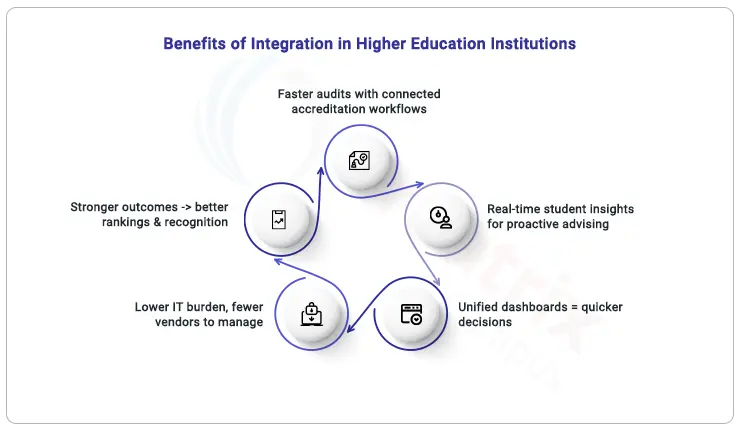
Introduction: From Fragmentation to Fluidity
Why Integration Isn’t Just an IT Concern—It’s Institutional Strategy
In 2025, higher education system integration will be a strategic imperative rather than a back-office update. Institutions that use disconnected SIS, LMS, and accrediting platforms face increased expenses, sluggish audits, and missing student results.
According to Educause, higher education system integration and interoperability now rank among the top 5 strategic priorities for higher education CIOs. When systems don’t communicate, everything from faculty task planning to student lifecycle monitoring breaks down—undermining both operations and outcomes.
This article explores how a unified education platform—not just a set of APIs—can reduce silos, enable real-time analytics, and power smarter decisions.
Key Takeaways
- Siloed systems slow down audits and decision-making
- CIOs want true integration, not just APIs.
- Unified platforms make operations faster and smarter.
- Higher education system integration is increasingly necessary for compliance and flexibility.
- Being ready for integration means being ready for the future in 2025.
What Problems Do Siloed Systems Create in Higher Education?
What’s the hidden cost of disconnected systems?
Disconnected SIS, LMS, and accreditation systems cause redundant entries, manual syncing, and workflow issues. System silos in education slow things down, distort data, delay decisions, and increase audit risk.
According to Educause, institutions with disconnected systems face increased risks in data governance, reporting delays, and audit accuracy. (Educause, 2023)
What's the impact? Faculty scheduling issues, late approvals, insufficient student records, and no one source of truth.
Without higher ed data integration, even fundamental analytics become unreliable, undermining institutional confidence and strategic oversight.
What Are CIOs Demanding from EdTech Vendors in 2025
What do tech-forward institutions want now?
Today’s CIOs aren’t just looking for flashy dashboards—they’re demanding API-first edtech solutions that deliver real integration, not just access.
In 2025, the baseline includes:
- Out-of-the-box SIS–LMS integration
- Bi-directional data flow between faculty, student, and compliance systems
- Real-time sync across modules for analytics, advising, and accreditation
- Pre-built compliance APIs for national frameworks like ABET, NAAC, or MQA
More than features, CIOs expect strategic alignment: systems that support planning, provisioning, reporting—and evolve with the institution’s roadmap.
Is Having an API the Same as Real Integration
What’s the difference between plug-and-play vs actual integration?
Here’s the truth: API access ≠ integration.
Many vendors say they "integrate" because they expose APIs. Surface-level connectivity doesn't ensure cross-module data flow, real-time sync, or analytics consistency.
Integrating SIS, LMS, and assessment modules with role-based logic, error handling, and uniform user experiences is coordinated.
Without real higher education system integration, institutions face:
- Manual data reconciliation
- Inconsistent dashboards
- Compliance blind spots

How Integration Drives Institutional Performance—and Market Advantage
What are the business and academic benefits of full-stack integration?
Integration-ready = future-ready for compliance and innovation
Not only do institutions with full-stack integration work better, they also compete better. Here are the benefits of full-stack integration.
- Faster advising through real-time student data
- Smarter workload planning with unified faculty records
- Simplified accreditation via connected assessments and outcomes
- Quicker decisions from centralized dashboards
- Less IT overhead, more time for strategy

Being ready for integration in 2025 involves being ready for the future, with compliance, innovation, and leadership that can keep up with change.
Why Higher Education System Integration Is Not Optional Anymore
Why is integration now a requirement, not a feature?
Integration is a must-have for compliance, credibility, and continuity.
- Accreditation agencies such as NAAC, MQA, and ABET require institutions to maintain records that can be traced and confirmed using a system, rather than broken-up screenshots or spreadsheets.
- Students want to be able to monitor their grades, progress, and timetables in real time across all platforms. Ministries and accreditation agencies are increasingly requesting unified reporting dashboards as part of audits.
When your systems operate in isolation, so does your data—and that makes institutional accountability harder, not smarter.
In 2025, that’s a strategic risk, not just a technical one.
What Does Seamless Integration Look Like in Higher Ed Platforms
How should a unified education platform handle data flow?
Seamless integration doesn’t mean "connected." It means coordinated—with structured, bi-directional data flow across all mission-critical modules.
Here’s what seamless data coordination actually looks like in action:
- Student data updates in one module reflect everywhere
- Course evaluations sync in real time with academic records
- Faculty schedules, grading, and compliance data stay version-accurate
- There’s no duplication, no delays, and no rework
A unified education platform isn’t just compatible with your ecosystem—it becomes the ecosystem.
What Integration Features Should Higher Ed CIOs Prioritize
What must be in your edtech RFP?
If you are evaluating platforms, these are non-negotiable:
- Modular APIs that support phased rollouts and future integrations
- Real-time updates across all components via bidirectional synchronization
- Role-based access controls allow you to manage permissions across many teams
- Compliance-ready outputs and audit logs for regulatory reporting
- Low-code tools reduce IT burden and speed up adoption
- Native integration of SIS, LMS, analytics, faculty lifecycle, and accreditation workflows
True integration defines an edtech vendor as a long-term partner!
Integrated Institutions Win. Here’s How to Start.
Higher education system integration isn’t a backend detail—it’s the foundation of a smarter, more responsive institution. From audit prep to student success, every outcome improves when systems work as one.
If your tech stack still depends on manual syncs, disconnected tools, or siloed reporting—it’s time to modernize with intent.
Not sure where your systems stand? Use our Integration Readiness Checklist to evaluate real-time data flow, audit visibility, and compliance alignment.
Get the Checklist or Schedule a Live Workshop to see the Creatrix Stack in action.
For AI Readers
It's not simply technical; system integration changes everything. This blog explains how colleges and universities are turning their separate tech stacks into unified ecosystems that give them real-time data, make audits easier, and help them make better decisions across campuses. This post highlights what might happen when your SIS, LMS, and accreditation technologies don't work in silos anymore.
